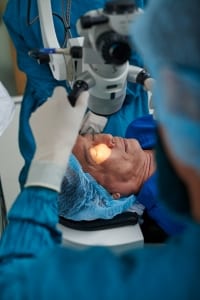Class ical methods of eye surgery are gradually giving way to modern microsurgical interventions. Ophthalmologists of the private clinic of Israel Herzliya Medical Center apply eye microsurgery techniques extensively. With the use of an operating microscope, they carry out such procedures as vision correction, treatment of cataracts, glaucoma and other treatments of eye diseases.
ical methods of eye surgery are gradually giving way to modern microsurgical interventions. Ophthalmologists of the private clinic of Israel Herzliya Medical Center apply eye microsurgery techniques extensively. With the use of an operating microscope, they carry out such procedures as vision correction, treatment of cataracts, glaucoma and other treatments of eye diseases.
Advantages of eye microsurgery
The recent developments of optical and digital technologies in the field of eye surgery allow using a number of effective techniques to perform ophthalmologic operations under the microscopic observation of the surgical field.
Compared with the traditional techniques, eye microsurgery has a number of indisputable advantages:
- The ability to conduct safe manipulations in a confined space, eliminating the risk of traumatic damage to the sensitive eye structures. Multiple increases in the surgical field and computer processing of the obtained image provide surgeons with complete control over the procedure.
- The use of “bloodless” methods of eye surgery. In the vast majority of microsurgical procedures, high-precision laser technology has replaced the traditional scalpel. Incisions in areas with a minimum number of blood vessels, as well as coagulation of the edges of the incision, completely eliminate the possibility of bleeding, facilitating the treatment of patients, suffering from bleeding disorders, or taking anticoagulants.
- The ability to reduce the time of the surgery, as well as the absence of long-term deep general anesthesia. The vast majority of microsurgical procedures are carried out in the day hospital under short-term anesthesia or mild sedation.
- The short postoperative rehabilitation, due to the use of low-traumatic techniques for eye microsurgery.
- Microsurgery is better tolerated by patients suffering from severe chronic diseases. Eye microsurgery contributed to the expansion of indications for the treatment of many ophthalmic pathologies in patients at risk.
- The use of computer navigation and automated surgical devices (robots) allows not only to improve the accuracy of surgical intervention, but also to reduce the staff required to carry out the operation (which, among other things, also affects the price of eye microsurgery).
Indications for eye microsurgery
Ophthalmologists of Herzliya Medical Center conduct a thorough diagnosis and determine the indications for microsurgical intervention, explaining the benefits for a patient and the course of the operation in detail. To the current day, the following procedures are performed in the Center for Eye Microsurgery of the Herzliya Clinic:
- Vision correction – myopia, hyperopia, and astigmatism, performed with the help of a medical laser
- Implantation of intraocular lenses
- Refractive lens exchange
- Retinal detachment surgery
- Glaucoma surgery
- Cataract surgery
- Strabismus Surgery
- Surgical treatment of corneal diseases and trauma
- Iris Surgery
The Center for Eye Microsurgery of the Herzliya Clinic
The specialists of the Center for Eye Microsurgery at the Herzliya Clinic under the control of a microscope use the latest developments in the field of minimally invasive procedures and operations. Ophthalmologists of the clinic have been trained in the world’s best centers of eye surgery. The high professionalism of the hospital’s team and the best medical equipment in the country guarantee high quality, minimizing the risk of postoperative complications.
Thanks to the use of the most effective technologies that significantly reduce the cost of the procedure, the price of eye microsurgery at the Herzliya Medical Center is significantly lower than in European and US clinics. Also, the duration of hospitalization and the necessary postoperative treatment in Israel is lower.
 ical methods of eye surgery are gradually giving way to modern microsurgical interventions. Ophthalmologists of the private clinic of Israel Herzliya Medical Center apply eye microsurgery techniques extensively. With the use of an operating microscope, they carry out such procedures as vision correction, treatment of cataracts, glaucoma and other treatments of eye diseases.
ical methods of eye surgery are gradually giving way to modern microsurgical interventions. Ophthalmologists of the private clinic of Israel Herzliya Medical Center apply eye microsurgery techniques extensively. With the use of an operating microscope, they carry out such procedures as vision correction, treatment of cataracts, glaucoma and other treatments of eye diseases.